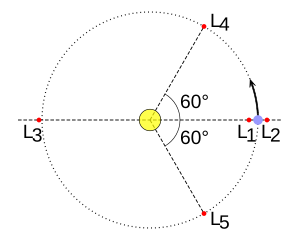Trojan asteroid facts for kids

Imagine a big planet like Jupiter orbiting the Sun. Now, picture smaller space rocks, called Trojan objects, that follow the same path as Jupiter. These objects travel about 60 degrees ahead of Jupiter (this spot is called L4) or 60 degrees behind it (this spot is called L5). Both the planet and these objects are orbiting an even bigger central object, like the Sun.
Trojan objects don't stay exactly at these L4 or L5 spots. Instead, they gently drift around them, almost like they are slowly circling the spot itself. The most famous Trojan objects are the many asteroids that orbit the Sun along with Jupiter. These are known as the Jovian Trojans. There are two main groups of them, one group on each side of Jupiter.
Contents
What Are Trojan Objects?
How Do Trojan Objects Stay in Place?
In 1772, a French mathematician named Joseph-Louis Lagrange discovered something amazing. He found two special places in a planet's orbit where smaller objects could stay put. These places are called Lagrange points. If an object was placed there, the gravity from the two bigger objects (like the Sun and Jupiter) would balance out. This balance would keep the smaller object stable. Lagrange predicted that groups of small bodies would exist at these stable points in Jupiter's orbit.
Why Are They Called Trojans?
The name "Trojan" comes from an ancient Greek story, the Trojan War. The first Trojan asteroids found orbiting Jupiter were named after characters from this war. It became a tradition to name the asteroids at Jupiter's L4 point after Greek heroes. Asteroids at the L5 point were named after Trojan heroes. There were a couple of mix-ups, though! For example, 617 Patroclus is a Greek hero but was put in the Trojan group. And 624 Hektor is a Trojan hero but was placed in the Greek group.
Discovering Trojan Objects
First Sightings of Trojans
The first person to ever see a Trojan asteroid was Edward Emerson Barnard in 1904. He thought it might be a moon of Saturn. But in February 1906, a German astronomer named Max Wolf saw another Trojan asteroid. He knew exactly what it was and named it 588 Achilles. This was the first time someone identified a Trojan asteroid correctly.
Since then, astronomers have found more than 2,000 Trojan asteroids. The largest one known is 624 Hektor. It's about 370 kilometers wide! Scientists believe that Trojan asteroids are made of ice and dust.
Trojans Beyond Jupiter
Over time, astronomers found Trojan objects orbiting other planets too. They found them near Neptune, Mars, and even Earth. These asteroids, not orbiting Jupiter, are sometimes called Lagrangian asteroids.
- There are four known Mars Trojans: 5261 Eureka, 1998 VF31, 1999 UJ7, and 2007 NS2.
- Eight Neptune Trojans have been found. Scientists think there might be many more Neptune Trojans than Jupiter Trojans!
- In 2011, the first Earth Trojan was confirmed. It's called 2010 TK7.
Earth's Own Trojan
Astronomers found a Trojan asteroid that shares Earth's orbit around the Sun. This space rock, named 2010 TK7, is located in Earth's L4 Lagrange point. This means it travels ahead of Earth. It's about 80 million kilometers away from Earth. It won't come closer than about 25 million kilometers. Scientists believe its orbit will stay stable for at least the next 10,000 years.
An orbiting telescope helped find 2010 TK7. This telescope, called Wise (Wide-field Infrared Survey Explorer), was launched in 2009. It uses infrared light to see objects in space. Wise looked at over 500 Near-Earth Objects (NEOs), and 123 of them were new discoveries. Later, another telescope, the Canada-France-Hawaii Telescope, confirmed that 2010 TK7 was indeed an Earth Trojan.
Related pages


